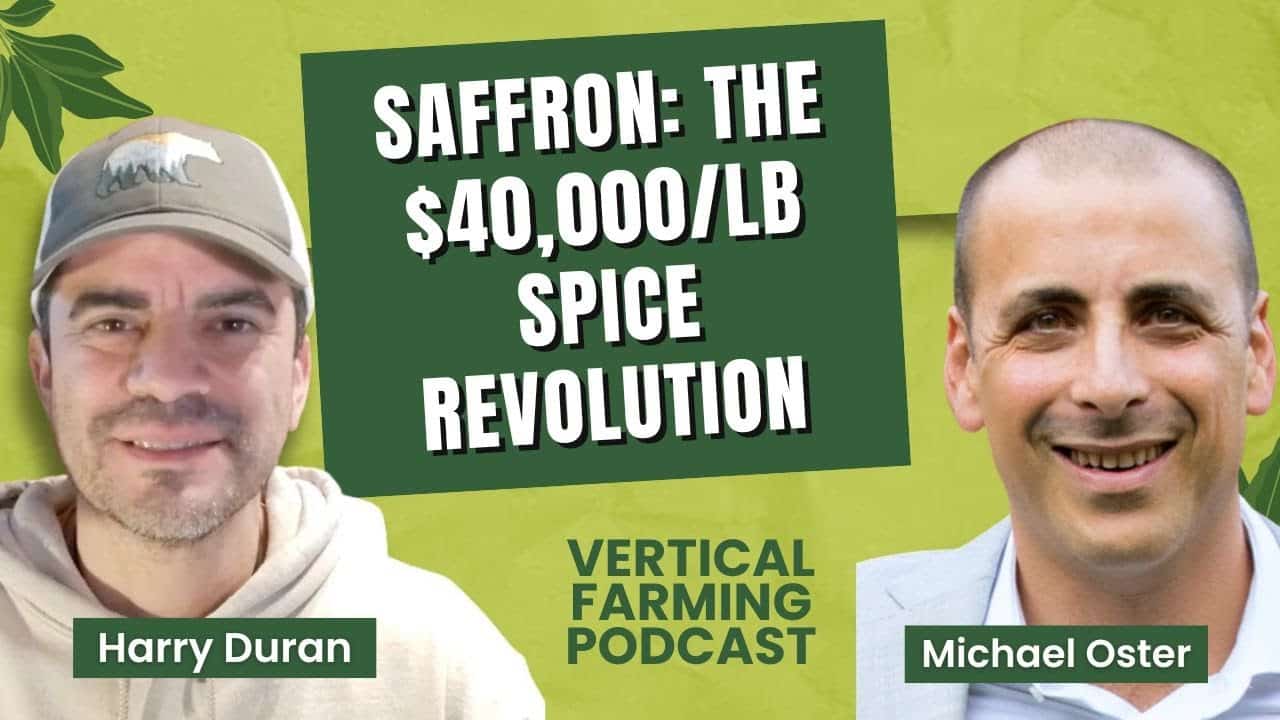Key Takeaways
- Michael Oster shares his path from energy and real estate into controlled environment agriculture.
- Saffron Tech is pursuing commercial production of high-quality saffron using vertical farming systems.
- Oster outlines the challenges of scaling from R&D to commercial output.
- The company is exploring both spice and medicinal markets for saffron.
- A small internal team is supported by external agronomy and engineering advisors.
Michael Oster Shares Background and Role at Saffron Tech
During an episode of the Vertical Farming Podcast, host Harry Duran & Michael Oster, CEO of Saffron Tech (Profile), discussed his entry into agriculture after more than two decades in energy and real estate. After returning to Israel from Texas, Oster was invited to join Saffron Tech’s board. Eight months later, he transitioned into the role of CEO.
Oster explained that although he had no prior background in agriculture or vertical farming, the opportunity to guide the company’s commercial strategy was aligned with his previous executive experience. “My background is in managing businesses, overseeing M&A, and working across industries. This was a new sector, but many of the fundamentals apply,” he noted.
From R&D to Commercialization: Saffron Tech’s Growth Plan
Scaling With a Phased Approach
Oster described Saffron Tech’s progression from research and development to a pilot facility, which is now producing high-grade saffron. The next step is developing a full-scale commercial plant. Rather than accelerating too quickly, the company is adopting a measured approach to avoid common scaling pitfalls.
“A lot of businesses fail when they assume lab-scale success translates directly to commercial scale,” Oster said. “We’ve prioritized data collection and pilot validation before moving into full production.”
Why Saffron? Evaluating Crop Economics
Considerations for Controlled Environment Agriculture
According to Oster, saffron’s value profile is distinct from more commonly grown crops in vertical farming systems. Saffron can sell at a wide range of prices depending on quality and source, from $500 to $40,000 per pound. Producing it is resource-intensive: approximately 120,000 flowers are needed to yield a kilogram of dry saffron.
Given the capital and operating costs of vertical farming, Oster stated that Saffron Tech’s choice of crop was based on its higher potential return per unit of production. “For vertical farming to work at scale, the economics of the crop have to justify the infrastructure. Saffron presents that opportunity.”
Medicinal Applications and Market Outlook
Beyond culinary uses, Oster noted increasing interest in saffron-based supplements and therapeutic products. Saffron has been studied for potential benefits in areas such as cognitive function, mood regulation, and skin health. Saffron Tech is currently focused on commercial production but has longer-term goals of entering the nutraceutical and pharmaceutical markets, pending clinical trials and regulatory approvals.
“The pharma side is not our immediate focus,” Oster clarified. “But our strategy is to establish a commercial foundation first and then expand once we have the capacity and product base to support clinical development.”
Team Structure and Strategic Support
Saffron Tech currently operates with a small core team of four, including Oster, a chief agronomist, an engineer, and an operations lead. The company also works with part-time financial support and consults with advisors from Israel’s Volcani Institute and Spain’s Valencia region on agronomy and extraction processes.
“We rely on a lean internal structure with external support from domain experts,” Oster said, comparing the setup to private equity teams that manage large portfolios with limited internal staff.
Final Considerations from Michael Oster
Reflecting on business fundamentals, Michael Oster emphasized the importance of conservative planning, especially when entering high-capital sectors like controlled environment agriculture. He underscored the need for realistic budgeting, reliable off-take agreements, and a disciplined approach to expansion.
“Excel can give you any number, but performance matters more,” he said. “We’re taking a risk by moving forward, but we’re doing so with a focus on minimizing uncertainty.”


